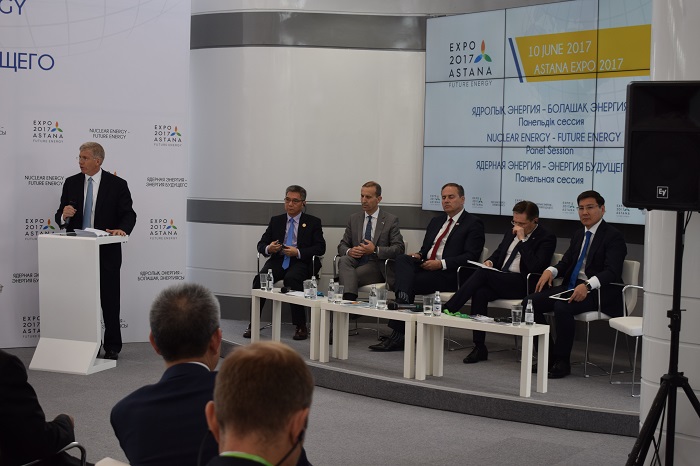Expo 2017 opens in Astana, Kazakhstan
Nuke firms see lower environmental impact
Published : 11 Jun 2017, 00:42
Updated : 11 Jun 2017, 11:44
Heads of nuclear power companies from across the world at a meeting during the Expo 2017 in Astana, Kazakhstan on Saturday claimed a significantly lower environmental impact of nuclear energy.
Multiple discussions took place on the opening day of the expo where the panellists compared the nuclear energy with other energy sources.
They stressed a significantly lower environmental impact of nuclear energy versus energy sourced from hydrocarbon such as coal or oil as well as its cost efficiency versus solar, wind and other alternative energy sources.
Additionally, the World of Nuclear Energy pavilion created in conjunction with Kazatomprom (National Atomic Company of Kazakhstan) and international nuclear energy partners promotes the use of nuclear energy as well as alternative uses for atomic energy. “The exhibition consists of nine thematic areas, which give information about the uranium industry, the safety and environmental compatibility of atomic energy, on modern achievements [in atomic energy], and prospects for the development of this industry,” the organisers said in a press release.
 A number of countries have already set up their pavilions in the three-month long expo, while a number of countries are in the process of setting up their pavilions.
A number of countries have already set up their pavilions in the three-month long expo, while a number of countries are in the process of setting up their pavilions.
The USA opened their pavilion first, which features multiple video presentations, including a message from the US Ambassador to Kazakhstan George Krol.
The pavilion also includes a scale model of various alternative energy generation methods. Openings continued throughout Saturday, many featuring live dance, music and short speeches from dignitaries, and will continue for the next few days. Finland’s pavilion named ‘Sharing Pure Energy,’ however, was not completely ready on the opening day.
The Finnish pavilion is comprised of half a dozen specialised exhibits, arranged like small rooms inside a stylised Arctic cave. The exhibits focus on Finnish companies’ innovative green technologies, water reclamation and purification, Finland’s education system and more.
The pavilion is staffed by Kazakh and Russian students living in Finland, as well as a few Finns. A volunteer described the Finnish pavilion as among the most interesting at the expo. The Kazakhstan pavilion, nestled inside the great chrome sphere at the centre of the expo, boasts a variety of exhibits on renewable energy, as well as contemporary sculptures, a retelling of Kazakh folklore using the latest technology, an exhibition on the Kazakhstan Tokamak – an experimental machine for testing nuclear fusion materials, among other things.
Expo 2017 Director Akhmetzhan Esimov at a press conference praised the architecture and construction of the pavilion and the other Expo buildings. “Our Sphere will be as remarkable as Brussel’s Atomium,” Esimov said, lauding the technology and materials that ensure the landmark’s longevity.
"Following the end of the expo, the sphere will remain as a museum for the future… and visitors will remain interested in the best practices area,” he said, adding that it displays revolutionary technology in future energy.
EXPO 2017 will continue until September 10 with more than two million people expected to participate in.
The main theme of the expo is ‘Future Energy.’ One hundred and fifteen countries and 20 international organisations ware expected to present innovations in reducing energy use as well as new technologies and alternative energy sources.


